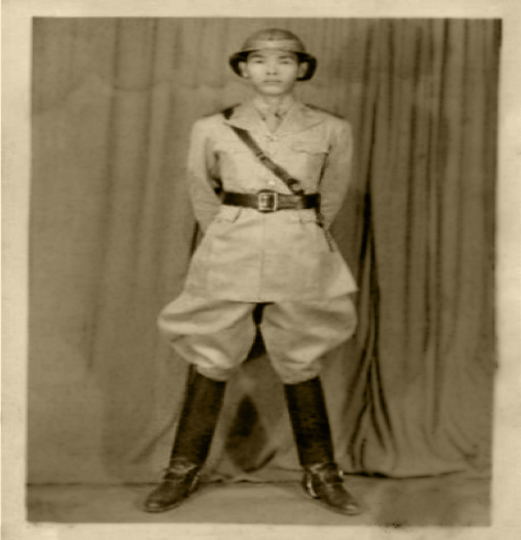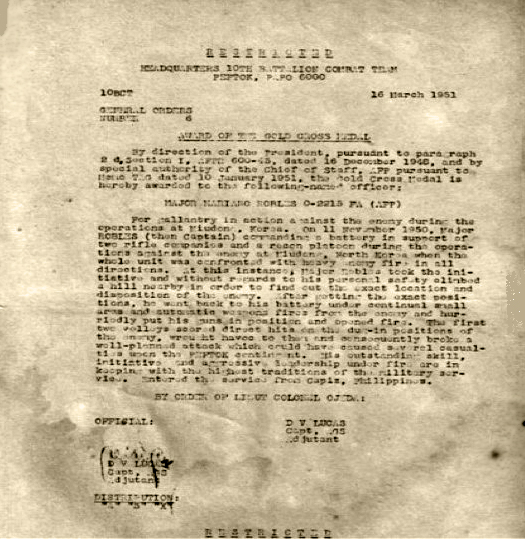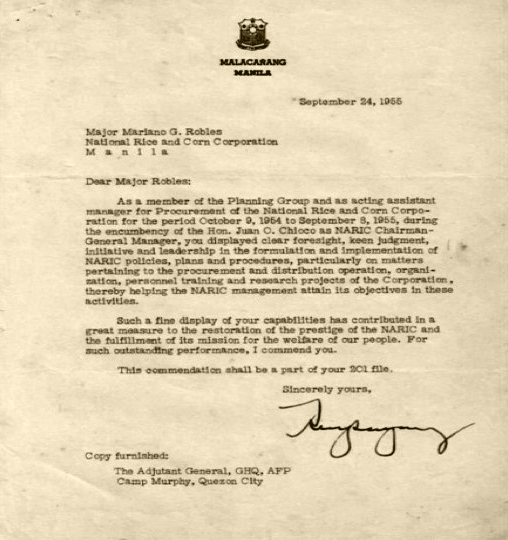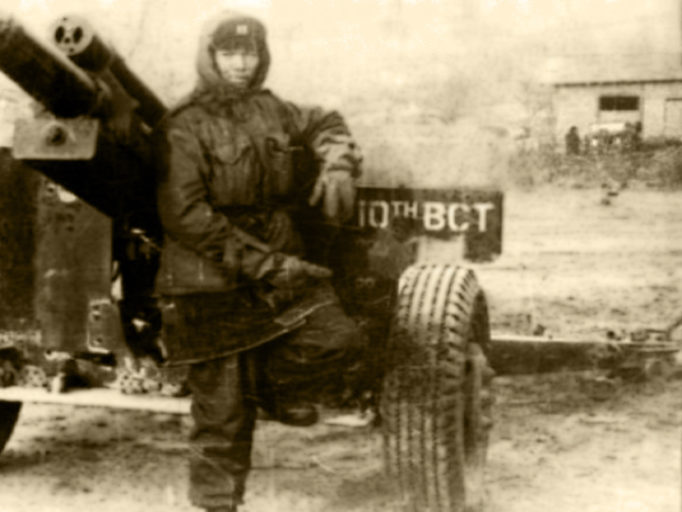Arduous Beginnings
Nicknamed “Tangkad,” Col. Mariano G. Robles could easily be picked out in a crowd or even battlefield. But it was his sharp analytical mind and photographic memory that stood out even more than his 6’4” stature. His other nickname, “Long,” was both a reference to his towering height and his unheard of ability to hit long-range targets with only one verifying shot.
Born on 16-May-1917 in Roxas, Capiz, Mariano Robles was the eldest of 14 children, and would spend his summers engaged in backbreaking labor to help support his family. His first job was at a Chinese grocery store where he would carry large bottles of wine on his shoulders, at age 10.
Early Military Aptitude
Not long after graduating at the top of his class in a vocational school, Mariano was drafted to undergo six months of military training, which he followed up with another six months in the officer Candidate Course. Robles, again, finished at the top of his class, composed of 71 draftees.
By July 1939, he was a commissioned Reserve Officer and, soon after, became a Battery Commander in the Artillery, responsible for training all officers at Fort Stotsenburg in Dau, Pampanga.
Mariano Robles saw action as a Captain in Bataan where he destroyed eight Japanese artillery batteries from his observation post now the site of the famous cross-shaped monument for gallantry at Mt. Samat.
Artillery is a class of heavy-hitting long-ranged weapons that require special and training and aptitude to wield, manage, and maintain. Used correctly, it can be a powerful tool that turns the tides of battles. Not just any ground infantry or reconnaissance personnel can operate a mortar or Howitzer.
As a Battery Commander and training officer, Robles became known for his exemplary skills in map reading, gunnery, and canons. His quick mental math and analysis of the terrain enabled him to accurately measure distances kilometers away using only his fingers for sale, and he could direct fire within a few seconds.
It was known among his men that he never fired more than twice before giving the order to “fire for effect.” This was to avoid giving away his position.
Eluding the Death March
Capt. Robles refused to surrender to Japanese soldiers with the fall of Bataan. Instead, he took a small group of men and traversed the treacherous rolling hills surrounding Mt Natib. They traveled by night over rocky terrain, jumping over large crevasses in the dark.
During a lull in attacks from the Japanese, Mariano and his men traveled to the coast of Orani where they hired a small banca to take them to Bulacan. After a bout with dysentery and malaria, Mariano made it to Manila and avoided tragedy in the Bataan Death March. Eventually, Robles was able to board a boat back to his hometown in Panay Island.
Later that year, Capt. Robles joined the 6th Military District guerilla forces under Gen. Macario Peralta to engage the Japanese invading forces in Panay itself. Incidentally, it was Gen. Peralta who would later introduce Robles to his future wife, Rosalina Baldemor.
Robles then went on to head the artillery battery unit of the 10th Battalion Combat Team (10th BCT), which was assigned to patrols defending against the local communist guerilla movement known as the Hukbong Bayan Laban sa Hapón (The Nation’s Army Against Japan) or simply “Huks.”
Veteran Soldiers
Because of their guerilla warfare experience gained by fighting the Huks, the 10th BCT was the logical choice to be sent to the Korean War in 1950. It became the first Philippine Expeditionary Forces to Korea (PEFTOK) unit sent to Pusan (now Busan) at the southernmost tip of South Korea for training, and eventual combat.
“Poor as we are, this country is making a great sacrifice in sending you to Korea, but every peso invested in you is a sound investment for the perpetuation of our liberty and freedom.” said President Elpidio Quirino to members of the 10th BCT during send off rites in Manila on 15-September-1950.
With 1,468 troops, PEFTOK was the 5th largest contingent to the United Nation’s forces, and the only one from Asia.
What was meant to be an eight-week guerrilla warfare training program in Pusan was fast tracked to 10 days. So impressed was US Eighth Army’s assistant operations officer Col. Alex Lancaster that he boasted, “Give me the Filipino combat team and I will fight anywhere above the 38th parallel.”
Then 17-year-old war correspondent Benigno “Ninoy” Aquino Jr. became enamored with the 10th BCT and wrote several stories about the soldiers for the Manila Times.
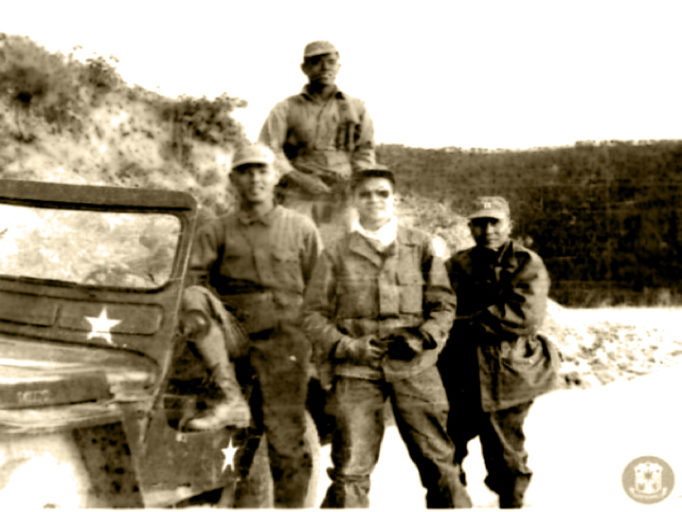
Capt. Robles towers over his well-maintained jeep while posing for a photo with young journalist and future National Hero, Benigno “Ninoy” Aquino Jr.
Holding The Pusan Perimeter
Indeed, the UN constantly relied upon the 10th BCT forces. Apart from making its presence felt in countless skirmishes, the 10th BCT also figured in major battles including the Battle of Imjin River, Operation Tomahawk, and the month-long Battle of Heartbreak Ridge, which was a major battle featured in a major motion picture starring Clint Eastwood.
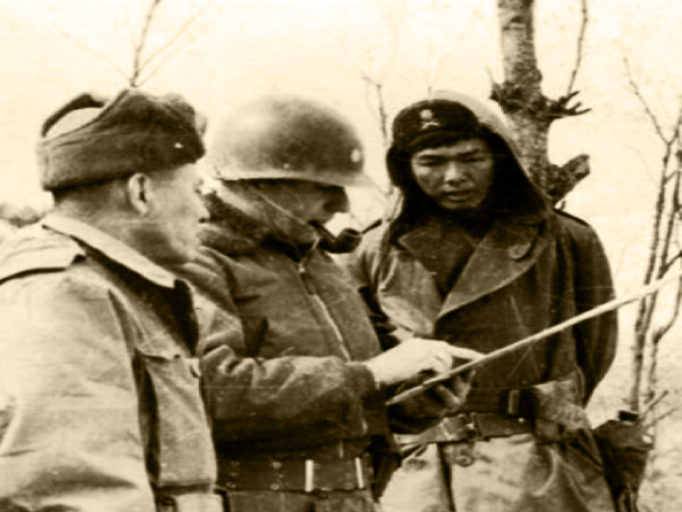
Capt. Mariano G. Robles receiving instructions from Gen. Douglas MacArthur, the Supreme Commander of the UN Forces, in Korea for Artillery Support in the mainline of resistance
As for Capt. Robles himself, his presence was greatly felt during the Battle of Miudong-Singye during which the 10th BCT was tasked to clear and secure the town of Singye just above the North Korean border.
On 11-November-1950, the group was caught in an ambush by two battalions of the Peoples’ Volunteer Army of China. Despite risk of harm or death, Capt. Robles, on his own initiative, climbed a nearby hill under enemy fire in order to find out the exact location of the Chinese.
Still under fire from small arms and automatic weapons, Robles returned to his long-range guns and repositioned his howitzers and gave the command for the Filipino troops to stay in their foxholes as he rained artillery fire that flew over their heads to decimate the enemy forces beyond. Capt. Robles was subsequently awarded a Gold Cross by order of Lt. Col. Dionisio Ojeda.
According to the award, “The first two volleys scored direct hits on the dug-in positions of the enemy, wrought havoc on them, and consequently broke a well-planned attack which could have caused several casualties upon the PEFTOK contingent.”
“By dusk, the Battle of Miudong-Singye was over,” wrote Fil V. Elefante for and article in the Philippine Graphic.
The 10th BCT was later sent to hold the frontlines beyond the 38th Parallel, deep into North Korean territory. The unit also figured heavily in the Battle of Yultong Ridge, during which it earned the title of “Stonewall of the UN.” Victory of this battle is said to have turned the tide of the war.
On 23-October-1951, after a year of fighting, the 10th BCT returned to the Philippines to a Heroes welcome.
“Initiative and Leadership” for NARIC
In 1954, Robles, now a Major, became the Acting Assistant Manager for Procurement of the National Rice and Corn Corporation (NARIC) in its inaugural year. Maj. Robles impressed his superiors with his unconventional theories in stabilizing the supply of rice and corn, and in regulating their prices throughout the country.
During his one-year stint, he earned glowing commendations from his superior officer Col. Jacinto Gavino, and no less than President Ramon Magsaysay, who had incidentally taken command anti-Huk campaigns in 1950.
“…you displayed clear foresight, keen judgment, initiative and leadership in the facilitation and implementation of NARIC policies, plans and procedures, particularly on matters pertaining to the procurement and distribution operation, organization, personnel training and research projects of the Corporation, thereby helping the NARIC management attain its objectives in these activities. Such a fine display of your capabilities has contributed in a great measure to the restoration of the prestige of NARIC and the fulfillment of its mission for the welfare of our people.”
Col. Robles was then stationed in Camp Murphy (now Camp Aguinaldo) as Executive Officer of Headquarters’ Service Group until he retired with the rank of Colonel in 1961. Although the retired colonel went on to become a successful entrepreneur, he was also a staunch supporter of veterans’ causes and rights until his passing on 10-July-1998.
Entrepreneurial Success in the Private Sector
Upon retirement, Mariano and his wife, Rosalina, went into their own cottage industry ventures in hopes to provide their growing family with a better standard of living. At one point, they pooled their money and invested most of their earnings in a fishpond business in Samar. Sadly, a tidal wave devastated the area before they could see a return on their investment.
Despite this major setback, the Robleses moved back to Manila and founded Robles Metalcraft in 1964. In its current iteration, Robles Metal has branched out into Bluesteel Industries Inc, which caters to zero-VAT export clients, while Arrem Industries caters to the domestic burgeoning market. Their products include complex machinery enclosures, high-voltage control boxes, precision production line equipment, etc.
Bluesteel Industries Inc. operates from a 5,200 sqm (2,600 sqm plant) facility in Cubao, Quezon City, employing 100 factory workers and 30 office staff. Among its clients are P. IMES Corp, Citizen Machinery, and Kyowa Manufacturing, with end-users like, Intel, Komatsu, and LG Electronics.
The 3,000 sqm production facility of ARREM Industries Inc. is located at the Light Industry and Science Park I in Cabuyao, Laguna. Its clients have included Coca-Cola Bottlers Philippines, American Vending Machines, and Liwayway Marketing Corporation among many others.
Each facility has its own laser cutting, CNC punching, bending, and painting facilities while Bluesteel Industries has recently acquired a laser welding machine.
Reference:
- Philippine Graphic (22-April-2013). The Forgotten Tale of the Philippine Expeditionary Forces to Korea.

